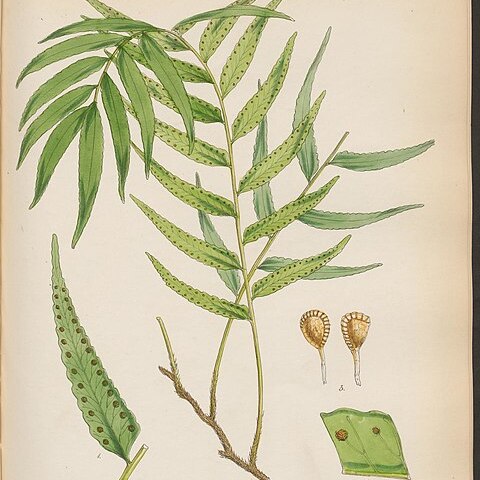Epiphytic or lithophytic ferns, usually rooted in the ground. Rhizome slender, long-creeping; upper surface bearing elongate tapering scales with peltate bases; lower surface closely adhering to substrate by means of dense short hairs. Fronds simply pinnate, not markedly dimorphic. Stipes scattered along rhizome, articulated to a phyllopodium; stipe and rachis grooved on upper surface. Pinnae articulated to rachis, generally lanceolate to falcate; anterior margin at base often auriculate; venation open, simple or forked; hydathodes prominent at vein endings on upper surface of pinnae. Sori superficial, usually in a regular row at vein endings and parallel with margins; indusium reniform to round, or absent. Spores spherical to ellipsoidal; surface with irregular wing-like folds.
Sori dorsal, in a single row on each side of costa, terminal on veinlets. Indusium round-reniform to vestigial. Sporangia of mixed maturation; spores oblong, with epispore. Rhizome epiphytic, far-creeping, solenostelic, paleate. Stipites articulated at or near rhizome. Fronds pinnate, articulated to rhachis; veins free. About 20 spp., mainly of New Guinea, New Caledonia and Madagascar. Genus published in Hook. f. Fl. N.Z. 2, 1855, 53.
Plants epiphytic, with long twining, wiry rhizomes. Rhizomes with peltate scales, with 2 rows of fronds. Fronds distant, articulate to phyllopodium; lamina pinnate; pinnae close together, subsessile. Venation free, 2 or 3 times forked. Sori orbicular, in a single row between costa and margin; indusia reniform; sporangia long stipitate, annulus with 10-13 thickened cells. Spores elliptic; perispore granular. n = 41.
Stipes jointed to rhizome or to outgrowths from rhizome

